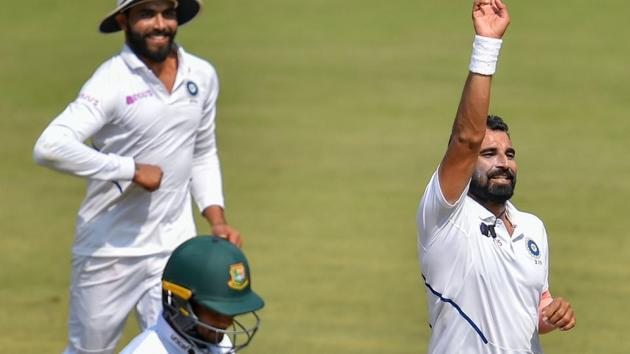India vs Bangladesh: Indian pacers script another big win for Kohli & Co.
India won by an innings and 130 runs to go 1-0 up in the two-Test series, firmly on course to complete a 12th successive series win at home.
After Day 2, double centurion Mayank Agarwal had said the Holkar Stadium pitch was still hard but had settled down nicely. The clinical precision with which India wrapped up Bangladesh’s second innings on Day 3 however showed favourable pitches or not, India have a bowling attack good enough to breathe life into any surface. The current unit is so balanced that it is now expected to bag 20 wickets on any surface. At home, the big question is how quickly. Also, how the share of wickets between pacers and spinners would look like.

As of now, it’s slowly tilting towards pacers. Like in the first innings, Ishant Sharma, Mohammed Shami and Umesh Yadav shared seven wickets. R Ashwin took two in the first and the remaining three in the second. Saturday morning saw a first in a very long time when pacers had a go from both ends throughout the first session. Against South Africa in Pune, spinners had taken 10 wickets and in Ranchi the Ashwin, Shahbaz Nadeem and Ravindra Jadeja had bagged just eight. Maybe it’s time to get used to new times. Gone are the days when India were notorious world over and criticised—sometimes even at home—for preparing dust bowls and bringing on spinners right away in the second innings. Fast bowlers, at least for now, are taking the lead in dismantling visiting teams.
Also read: It will be great if we revisit Bangladesh’s Test cricket structure - Mominul Haque
Bangladesh hadn’t lasted a full day in the first innings. In the second innings too, needing 344 runs to make India bat again, they were bundled out for 213 with at least 19 overs remaining for the day. India won by an innings and 130 runs to go 1-0 up in the two-Test series, firmly on course to complete a 12th successive series win at home. This was India’s sixth successive Test win since the draw against Australia in Sydney, to complete a historic series win Down Under, and their third successive innings victory after Pune and Ranchi. Since their loss to Australia in the second Test in Perth last December, India have won seven of the eight Tests they have played, with the only draw coming in Sydney in January.
“The hunger to stay at the top gives rise to performances like this,” said batting coach Vikram Rathour. “It is now a culture that is fully drilled in these boys and that is the only secret.” Bowling coach Bharath Arun said: “The pace attack we have is probably the most experienced and most skilful in the world. We have added (bowling) discipline to it and this is the result you are seeing. The four-five world class Test pacers we have is a luxury. Probably our most important job as support staff would be to look after their workload so that we can get them fresh for every single Test we play.”
“Sometimes you feel that every spell our pacers bowl, something is happening or they make it happen,” Ashwin said here. “I think Shami, Ishant and Umesh have been bowling well as a pack and if you add (Jasprit) Bumrah to it over the last few months or a year, I think it’s one of the most lethal pace attacks going around in the world if not the best. And I am saying that as a disclaimer, I don’t want people judging me on that comment. But it’s right up there and one of the best bowling attacks I have seen in recent times,” Ashwin said. “They have been exceptional, especially if you look at Umesh. Over the last few years since 2016 when the home season started, he has always given us an early breakthrough. Ishant has been splendid and Shami is probably in his best rhythm in his entire career,” Ashwin added.
Also read: Virat Kohli fan invades stadium, gets a side-hug from the captain
On Saturday, Sharma did to Bangladesh’s left-handed opener Shadman Islam what Shami had done to clean up Mushfiqur Rahim— right-handed batsman—in the first innings. Sharma’s delivery cut in sharply to disturb the top of off-stump after snaking through Islam’s defence. It was probably the ball of the day. Apparently, Sharma, inspired by Shami, tried out this ball for the first time during practice on Friday during tea and at the end of day’s play. “So he was particularly happy with this wicket,” Arun said. “This is the hunger we were talking about,” he added. “Ishant is our most experienced pacer and even then he is eager. He keeps working on his bowling. He was always economical. But he now makes the batsmen play more often and that is why he is becoming more dangerous.”
Among Bangladesh batsmen, only Mohammad Mithun and Liton Das were dismissed while trying to counterattack. The rest of their regular batsmen were beaten all ends up and were either bowled, caught in the cordon or trapped leg-before. Mithun played a needless pull when a partnership with Rahim was starting to take shape. Das, looking to go over the bowler’s head, charged out and offered a return catch to Ashwin. Rahim’s was the ninth wicket to fall after a reprieve from Rohit Sharma off Shami early on at second slip. Rahim was finally felled courtesy a brilliant effort from Cheteshwar Pujara running from mid-off to long-off and taking the catch over his shoulder.
Both India and Bangladesh will have their first full practice session with the pink ball here on Sunday and have another two session lined up at the Eden Gardens ahead of their maiden day-night Test beginning on November 22.






